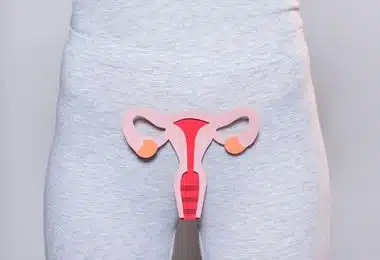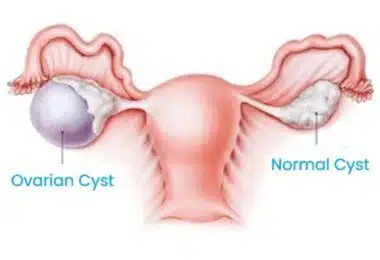
Prolapse of The Bladder, Uterus, And Rectum (Pelvic Organ Prolapse)
November 15, 2022
Non-Invasive Diagnostic Methods -The Ones That Involve No Risk
November 15, 2022
Prolapse of The Bladder, Uterus, And Rectum (Pelvic Organ Prolapse)
November 15, 2022
Non-Invasive Diagnostic Methods -The Ones That Involve No Risk
November 15, 2022
Ovarian Cyst
Ovarian cysts are tumors that can form at any time, starting from the fetal period (the period of fetal development in the womb) and ending with the onset of menopause. Although the exact frequency of their occurrence is unknown, screening studies show that ovarian cysts are detected in about 7 percent of women.

Image-1: Ovarian cyst and normal cyst.
According to experts, the chance of getting ovarian cancer is about 1/60, or 1.7 percent. The mechanisms of ovarian cysts formation are, to some extent, related to the nature of the cysts themselves. Some cysts, called functional cysts, are associated with hormonal mechanisms, while others are neoplastic (self-developing). Although the concept of a cyst is often formulated simply as a bag filled with liquid material, in reality, it covers a much wider range of characteristics from benign cysts, to cysts containing malignant or even invasive malignant cells.
How Is An Ovarian Cyst Diagnosed?
Detection of ovarian cysts occurs by ultrasound in women who treat complaints such as bloating, pain in the groin area, etc., and sometimes it happens completely by accident. For example, sometimes ovarian cysts are randomly recognized by magnetic resonance imaging (MRI) or computed tomography (CT) scans performed for some other reason. Although rare, ovarian cysts may also occur, which are accidentally detected during routine pregnancy examinations.
Are Ovarian Cysts Harmful?
Ovarian cysts can cause problems both because of the presence of the cyst itself and its characteristics. Even if the cysts are not malignant, sometimes when they rupture, they can cause pain and lead to emergency surgeries, as well as when they rotate around their axis (torsion of the ovarian cyst), they can disrupt the blood supply to the uterus. If in such cases, surgical intervention does not follow, there may be negative consequences for both the ovary and the patient. (Video 1, which shows the treatment that we performed using laparoscopic surgery, demonstrates an image of an ovarian cyst during pregnancy).
In addition to the common problems of ovarian cysts, such as tearing and twisting (turning around its axis), they can also cause other problems, depending on the nature of the cells contained in them. If there are malignant cells in the cysts, then there is a possibility that they, having ceased to be local tumors, can begin to spread to other distant parts of the body.
Is It Possible to Determine Which of the Ovarian Cysts Are Benign And Which Are Malignant?
Ovarian cysts can cause problems both because of the presence of the cyst itself and its characteristics. Even if the cysts are not malignant, sometimes when they rupture, they can cause pain and lead to emergency surgeries, as well as when they rotate around their axis (torsion of the ovarian cyst), they can disrupt the blood supply to the uterus. If in such cases, surgical intervention does not follow, there may be negative consequences for both the ovary and the patient. (Video 1, which shows the treatment that we performed using laparoscopic surgery, demonstrates an image of an ovarian cyst during pregnancy).
In addition to the common problems of ovarian cysts, such as tearing and twisting (turning around its axis), they can also cause other problems, depending on the nature of the cells contained in them. If there are malignant cells in the cysts, then there is a possibility that they, having ceased to be local tumors, can begin to spread to other distant parts of the body.
How Is the Ovarian Cysts Treatment Done?
Observations of patients without a medical history, having small cysts that are presumably functional, may not be conducted for long. It is assumed that functional cysts should decrease over time. If this does not happen, or, on the contrary, their growth begins, you should start considering the possibility of surgical intervention as one of the treatment options. Ovarian surgery can be performed both open and closed (laparoscopic surgery). The main thing in the treatment is to remove the cyst. However, how exactly the removal will take place depends on the individual nature of each case. So, both the removal of the entire ovary and the ovary together with the uterus can be performed, as well as other larger operations (affecting all areas where there are lymph nodes and tumor tissues). Therefore, instead of developing a single general method of treating a cyst, it is necessary to plan and organize treatment following the characteristics of each patient.

